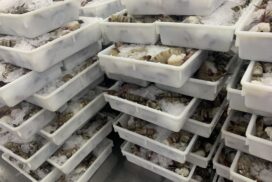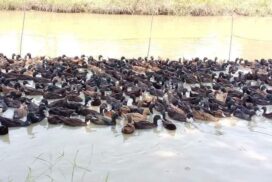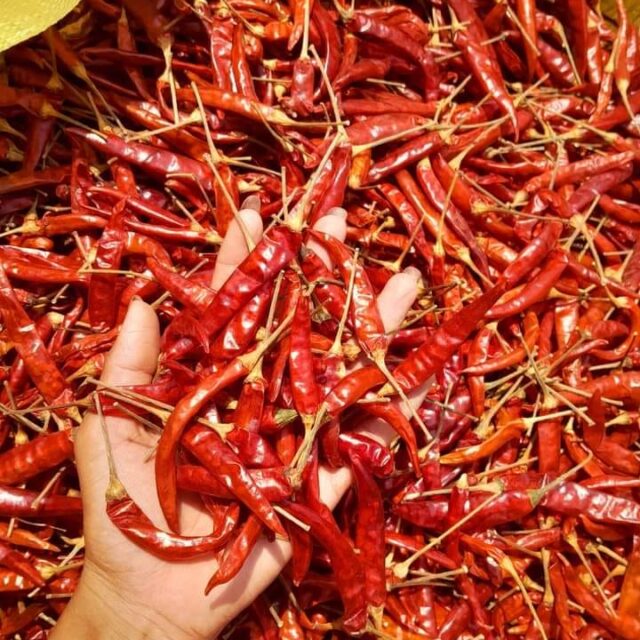Myanmar has its strategic long coastlines and belongs to the rich marine resources and mineral resources. Myanmar’s fishery product is beyond self-sufficiency. The agriculture and livestock sectors are the backbones of the country. Moreover, it generates foreign currencies from the exports of freshwater and saltwater aquaculture products. The livestock sector contributes to the country’s economic growth to a great extent. Livestock is an integral component of the mixed farming system and livestock production in harmony with nature can effectuate sustainable rural development.
Exporting countries of fish and fishery products
Myanmar’s farmers and fish breeders were previously engaged in cost-effective eel farming. However, limited resources of eel larvae posed difficulties for them to continue the commercially valued eel farming. Therefore, Myanmar’s eels are primarily caught from the wild and exported to foreign markets. Farming of native eels on a manageable scale can increase the income of the farms and also protect them from extinction triggered by over-exploitation from the natural habitats in central and lower Myanmar for a decade. It will also support the country’s fishery supply chain. The Department of Fisheries and the Myanmar Fisheries Federation are providing technical assistance to the breeders to achieve eel commercial farming as one of the fishery products exporting countries with rich marine resources.
Nutritional benefits of eel
People consider eels to be strikingly similar to snakes, yet there is high consumption of eels in some countries. Eel culture is a low-cost business and it is a profitable business. There are successful eel farms in some ASEAN countries. Mucus is covered in this snake-like boneless fish. It has an elongated and scale-less body. The dorsal and anal fins of the commercially important rice field eel, also known as swamp eel, are continuous around the tail tip. It is sex reversing. The culture of Asian swamp eels (Monopterus) is successful in fish farming lakes and stations in China, Indonesia, Viet Nam, Thailand and the Philippines. Eels caught from the wild and harvested from the farms are offered at a high price. Myanmar mainly exports them to China every year. Eel has 303 calories and 14 per cent of protein. People prefer eels as a nutritional food.
Eel culture enterprise with high profitability
Out of many eel species in the world, six species can be found only in Asia. Rice paddy eel and mud eel (Monopterus cuchia) farming with brick ponds on a manageable scale are seen. They are also bred with other types of lakes. This fishery product can be farmed all year round without chemical exposure. The eel can thrive in low-oxygen conditions. Eels eat Fish, snails, aquatic insects and boneless animals such as worms. It is a low-cost business with high profits.
Pond preparation of eel culture
For eel farming on a manageable scale, two (2x1x1 metres) ponds must be adjacent. The surface area of the two ponds is four square metres. Mud must be put into half of the lake (ten centimetres). The pond leaking problem must be fixed as well. After that, dried paddy straw must be covered at a ten-centimetre height. For the third stage, Banana stems must be layered to a ten-centimetre height. Cow dung (a ten-centimetre-high layer) must be added in four stages. After that, mud must be covered again. A steep bank structure must be maintained in the pond with stones. Breeders can make artificial lakes with tarpaulins as well.
Stages of eel culture
Rainwater or underground water can be added to the pond after getting rid of chlorine in the water. The water layer (15 centimetres) must be the surface area of the pond. This way, the component parts will be decayed. After one week, pond water must be removed and fresh water must be added. Fresh water must be changed every 20-25 days until foam disappears. Tilapia or carp fish larvae must be raised in the ponds on a trial run. If the fish do not die within three days, the pond is ready to farm the eels. The pond must be prepared like soil in a paddy field. Before eel larvae are added into that pond, water hyacinth must be put over the mud layer so that it can protect eels from sunlight and create a place to hide. About 200 eel larvae (60 male and 140 female) can be put into that pond. Eel is nine inches long at one year old. Eels can lay 100-700 eggs during spawning. Breeders must take extra care to take care of the eel larvae.
The mating season is commonly between May and June. The breeders who work on a manageable scale should choose eel larvae born during that season. Eel culture can be carried out with a one-year-old eel (17 centimetres) in healthy conditions. They can be raised in a concrete pond with a 50-centimetre-deep water level. About 12.5 to 15 centimetres long 100 eel larvae can be farmed in the lake.
Tips on feeding eels
Aquatic animal protein sources such as fish meal and feed mixed with bran can be utilized as supplementary feeding. Snail meal is also eel feed. Feeding time must be accurate. As eels are active at night, it is more effective if they are fed during the dark hours. Feed residue must be removed to maintain the water quality of the pond. Feed trays must be placed in the lower level of the pond for two days and pulled gradually. Eels must be closely observed to check whether they have an animal disease or not. Dried feed must be made into powder or meal. Feed must be well preserved as well.
Marketable eel
Measuring eel size must be undertaken biweekly for three months. Pond water must be changed once a month. Eel is 28-48 centimetres long at three years old. The fertile eel is 12 inches long (28 centimetres) for females and 20 inches long (46 centimetres) for males. The male is bigger than the female. The weight of the eel will increase from three kilogrammes to 20-30 kilogrammes after six months of breeding. After eels are harvested, the ponds must be dried for a few days to restart eel farming. Eels can be placed in the market through manageable eel farming.
Eel harvesting and handling practices
Grading eel size to reach market value and market conditions must be observed before eel harvesting. Continuous eel farming can be conducted if breeders prepare new ponds. Eels can be harvested easily at nighttime by pulling the feed tray. Proper handling during the harvesting is required not to damage the eel as it can result in loss to the breeding.
For post-harvest handling, eels must be cleaned. They can be transported in 10-gallon plastic containers with small amounts of water. About 15-30 kilogrammes of eels can be added into one container. It must have a 1 cm air hole. Suppliers can keep eels alive in the 0.75-metre-high plastic pond, timber pond or barrel. About 100-150 kilogrammes of eels can be put into one square metre place. A large amount of water must be added for keeping eels alive. Water must be changed twice a day. Feeding must be avoided during storing the eels.
Eels can be transported for 8-10 hours with the use of a 2.5 feet-high plastic box filled with water. The cover of the box must have an air hole. Handling practices is crucial for profit-making.
Eel nature and habits
Eel reproduction is found between March and September, mostly in July. Year-round spawning takes place. The highest mating season is the May-June period and the lowest season is December-January period. As eels can undergo sex reversal naturally. Male eels tend to make foams to create egg nests. After two or three days, Female eels lay eggs in those foam nests. The egg can hatch at 25°C. Monopterus albus is also known as rice field eel. Eels can be raised with any type of water except underground water, well-water, river water and saltwater.
Eel farming contributes` to ecosystem
Paddy fields are the natural habitat for eels. They help reduce the population of snails in the fields. The farmers commonly raise the eels near the fields. Nonetheless, eels can destroy field channels and cause water losses in the rice field. Prevention measures must be taken for the field channels. Snail is considered an invader and a problem to rice fields in Asian countries. Eels can support the ecosystem of rice fields. Eels are considered an ideal species for rice paddy farming. Mixed farming of eels and rice on a manageable scale is mostly found in the rainy season.
Eel is listed in the sixth place among ten major fishery products
Eels are yearly shipped to external markets. To conserve native eels and execute commercial livestock breeding under a mixed farming system, Myanmar Fisheries Federation conducted artificial seedling of eel production on a trial run in July 2022 in Twantay, Yangon Region and reaped a fruitful result. It enlightens the future of the farmers. The major fishery products of the country are rohu, crab, fish meal, large head hairtail, hilsa, soft-shelled crab, shrimp, squid, tiger prawn and eels. Out of them, the eel is placed sixth. Myanmar exported 8,849.69 metric tons (MT) of eels in the 2009-2010 financial year. The country generated US$31.022 million from exports of 8,661 MT of eels in the 2018-2019FY. There is an illegal export of eel to China. Eliminating illicit trade is required as the black market can negatively affect the long-term market and legal trade route.
Collecting eel larvae and conservation
Small-sized eels are caught for eel farming in Myanmar. Those larvae are not marketable. Brown and red eels with an average weight of 1.3 ticals are commonly farmed. The small eels from the wild are not large enough to reach export market value and they are offered at low prices in the domestic market as well. This being so, eels might be extinct from overexploitation and which leads to marine resource depletion. Eels are a commercially important fishery product in foreign markets. Conservation of eels and dissemination of artificial reproduction methods to the farmers can increase the revenue of the State and enhance the socio-economy of the rural community.
Future prospects of eel culture
There were 16 species of freshwater eel registered before 2019. In 2019, scientists discovered new eel species and two subspecies. Therefore, the number of freshwater eel species totalled 19. Out of them, six are found in Asia. Myanmar has two native eels; brown and red eels. Eels fetch the highest price in January and February. If eel farming is thriving, it can penetrate European markets beyond Asia. Being listed as one of the major fishery products, I wrote this article with an aim to improve the future prospects of the commercially valued eel farming business that can create job opportunities in rural areas and bring about social and economic benefits.















